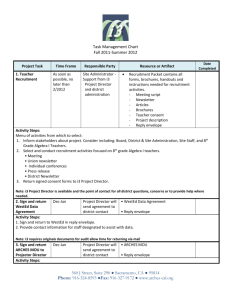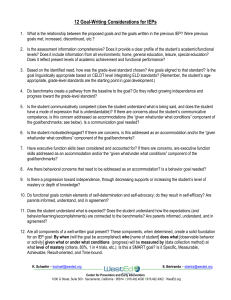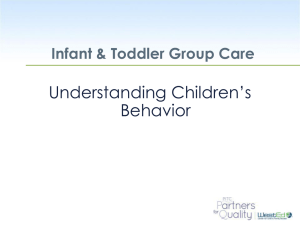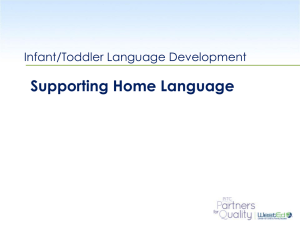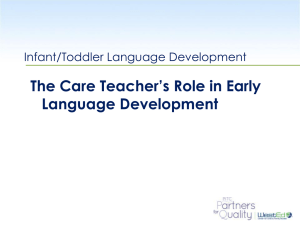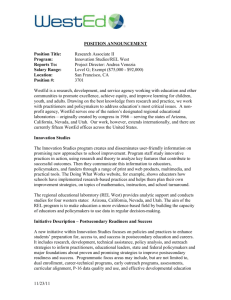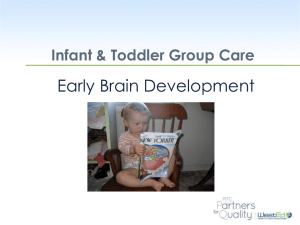Talk in the development of academic uses of English. of ELLs?
advertisement
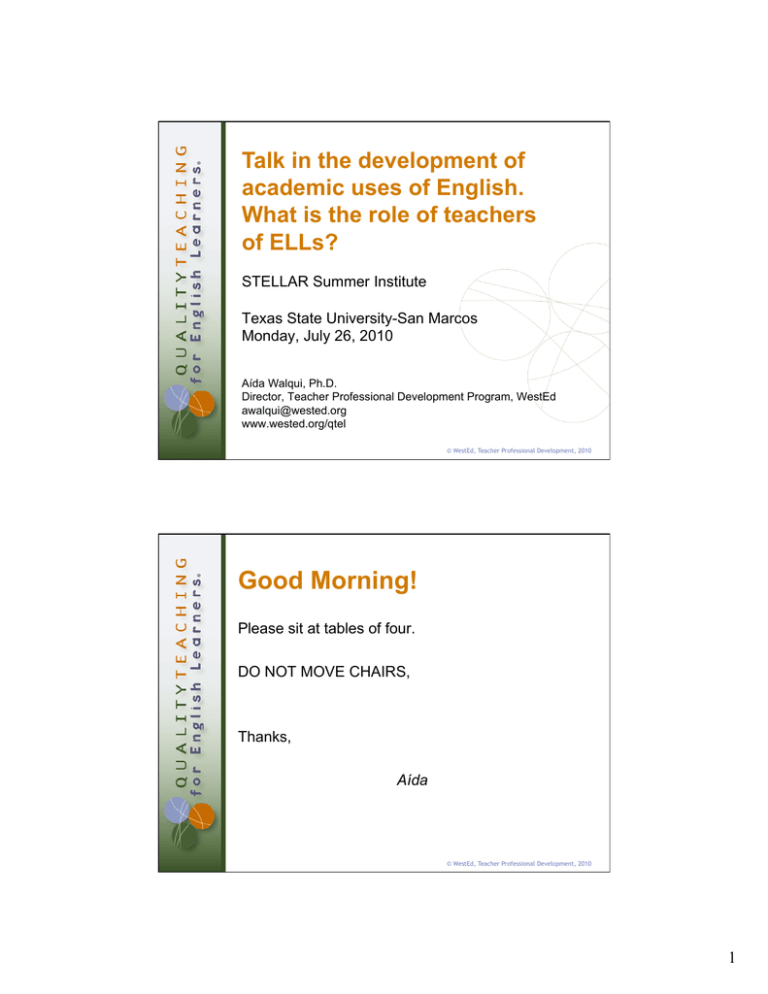
Talk in the development of academic uses of English. What is the role of teachers of ELLs? STELLAR Summer Institute Texas State University-San Marcos Monday, July 26, 2010 Aída Walqui, Ph.D. Director, Teacher Professional Development Program, WestEd awalqui@wested.org www.wested.org/qtel © WestEd, Teacher Professional Development, 2010 Good Morning! Please sit at tables of four. DO NOT MOVE CHAIRS, Thanks, Aída © WestEd, Teacher Professional Development, 2010 1 How does student oral production help language acquisition? • It elicits feedback • It forces syntactic processing • It allows learners to test hypothesis • It helps to appropriate explicit L2 knowledge • It helps learners develop their discoursal ability (the production of long turns) • It enables learners to develop their personal voice by introducing their own topics in an interaction • It serves as auto-input (learners pay attention to their own input) © WestEd, Teacher Professional Development, 2010 The role of teachers • To construct invitations that deliberately maximize opportunities for students to actively engage in discipline-specific talk. • To keep a keen focus on the balance among skills students possess, the demands of a task, and the supports offered: FLOW (Walqui and van Lier, 2010). • To help students become aware of and reflect on how authors use language to convey their points of view or interpretive perspectives (Gibbons, 2009; Schleppegrell, 2009; Walqui and van Lier, 2010) • To respond to students initially focusing on fluency and their appropriate use of the genre involved to then spiral back to issues of accuracy and complexity. © WestEd, Teacher Professional Development, 2010 2 The majority of classes are teacher-fronted Every time we see an instance of teaching we need to ask ourselves: Could this instance be transformed into one where all students are engaged in purposeful subject matter talk that provides them with apprenticeship into the academic uses of language, and consequently of important conceptual and academic understandings? © WestEd, Teacher Professional Development, 2010 Academic uses of English Involve constellations of features that together construct texts that are difficult for students because of: • the fields of knowledge they appeal to • the tenor of the interpersonal relationships they construct • the modes in which students encounter them These multiple variations result in academic language registers, or the linguistic variation that results according to contexts of use. © WestEd, Teacher Professional Development, 2010 3 CULTURE GENRE (Purpose) The Subject-Matter (Field) Who is involved? (Tenor) The Channel (Mode) REGISTER TEXT Derewianka, 1990 © WestEd, Teacher Professional Development, 2010 If we want students to gain appreciation of a particular genre and a critical stance toward it, we need to develop knowledge of : • the communicative purpose the genre is commonly used to achieve • the appropriate forms that are needed to construct and interpret text • content (field), stance (tenor), mode, and register typical of the genre • The contexts in which the genre is regularly found © WestEd, Teacher Professional Development, 2010 4 Genre: Definition A staged, goal-oriented, purposeful activity in which speakers engage as members of our culture. They have schematic or generic structures that might include a typical beginning, middle, and end. Genres are staged, culturally purposeful activities that users of a language draw on to get things done. (Martin, 1992) © WestEd, Teacher Professional Development, 2010 What is a task? • A task is an activity that is carried out as the result of understanding communicative events. • Tasks are concrete instantiations of support for student apprenticeship. • A task usually ends in a performance and has a clear beginning and an end. • Tasks engage students in predictable participation structures. © WestEd, Teacher Professional Development, 2010 5 Tasks Simple Tasks: • Think-Pair-Share • Anticipatory Guide Complex Tasks: • Oral Development Jigsaw © WestEd, Teacher Professional Development, 2010 Think-Pair-Share THINK: • Carefully about the question • Jot down your answers PAIR: • Find a partner • Next to you or l o n g distance SHARE: • Your answers orally • Be ready to present both answers 6 Anticipatory Guide Read the following statements and decide whether you agree with them or not Agree 1. Some people do not feel guilt, that is, they do not feel bad when they do something wrong. 2. Keeping secrets can hurt you because it is not good to keep things inside. 3. There is no such thing as fate, in other words, we CAN change our destiny. 4. Committing one crime leads to committing more crimes. 5. Ambition is a positive trait or characteristic. Disagree ✓ ✓ © WestEd, Teacher Professional Development, 2010 The Oral Development Jigsaw Teacher scaffolds the process. Review of the genre: Description • Discussion of purpose: why do people describe scenes to others? • Structure: Where does the scene take place? Who is the central character(s) in the picture? What does this person look like (approximate age,gender, height, face, hair, clothes)? What is this person doing? Any other relevant information? © WestEd, Teacher Professional Development, 2010 7 Preferred language: Teacher offers models of language that students may use: This scene takes place in … My picture shows … The picture I have shows a … The central character in my picture is In my picture you can see a … © WestEd, Teacher Professional Development, 2010 Jigsaw Project BASE GROUP Students work in heterogeneous groups and review the genre of description EXPERT GROUP Picture A Picture B Picture C Picture D Students describe their pictures following guidelines and models © WestEd, Teacher Professional Development, 2010 8 Jigsaw Project BASE GROUP Students work in heterogeneous groups and review the genre of description: purpose, structure, linguistic characteristics EXPERT GROUP Picture A Picture B BASE GROUP Picture C Picture D Students share their descriptions. Then discuss the genre of narrative to create one © WestEd, Teacher Professional Development, 2010 Text organization of narratives: Orientation Narratives usually begin with an orientation where the writer attempts to sketch in or create the “possible world” of the particular story. The reader is introduced to the main character(s) and possibly some minor characters. Some indication is generally given of where the action is located and and when it is taking place. An “atmosphere” is usually established and there is often some foreshadowing of the action to follow, drawing readers into the story and making them want to become involved. The orientation may be brief or it may extend for several pages. Details included are those which will enhance the later development of the story (personalities, type of situation, relationships). © WestEd, Teacher Professional Development, 2010 9 Text organization of narratives: Complication The story is pushed along by a series of events, during which some complication or problem arises This complication involves the main characters and often serves to (temporarily) thwart them from reaching their goals Narratives tend to mirror the complications we face in life and tend to reassure us that they are resolvable © WestEd, Teacher Professional Development, 2010 Text organization of narratives: Resolution The complication may be resolved for better or for worse, but it is rarely left completely unresolved There may be a major complication in the narrative which is not resolved until the end, with a number of minor complications along the way, which might be resolved in part or whole as they arise or later in the story. These are usually related to the major complication and serve to sustain the interest and suspense, leading to a crisis or climax © WestEd, Teacher Professional Development, 2010 10 Narratives: Language Features Many linking words to do with time: first, after that, suddenly, while, finally… Dialogue often included, during which the tense may change to the present or future Descriptive language chosen to enhance and develop the story by creating images in the reader’s mind Can be written in the first person (I, we) or third person (he, she, they) © WestEd, Teacher Professional Development, 2010 The Oral Development Jigsaw in Roza Ng’s Class Discussion of the purpose and generic structure of descriptions Students jointly create a description Individually students share oral descriptions with new groups Discussion of the purpose and generic structure of narratives Collaboratively students construct an oral narrative Students jointly write their narrative Narratives are performed Independent written narrative 11 Video Exemplar Teacher: Roza Ng School: MS 131, Chinatown, NYC Class: Intermediate ESL Students: Between 6 months and 2 ½ years in the U.S. © WestEd, Teacher Professional Development, 2010 Assessing the difficulty of a task adapted from: Brown, Anderson,Shillcock, and Yule. 1984. Teaching Talk. Strategies for Production and Assessment. Cambridge, UK: Cambridge University Press. Degree of difficulty Degree of difficulty Static task Dynamic task Abstract task Task A Task B Task C Description of one scene Description of 4 different scenes Construction of a narrative Many elements, relationships, characters, etc. (more difficult) Few elements, relationships, etc. (less difficult) © WestEd, Teacher Professional Development, 2010 12 What to focus corrective feedback on? Three major domains in oral production (Skehan, 1998) : • Fluency • Complexity • Accuracy Because second language learners have limited processing capability, when they are engaged in activity, they cannot attend to all aspects simultaneously, so they prioritize and derive differential results from their choices. In particular there is tension between complexity and accuracy. © WestEd, Teacher Professional Development, 2010 Fluency Fluency is the extent to which the language produced in performing a task manifests pausing, hesitation, or reformulation Measures of fluency: • Number of syllables per minute • Number of pauses of one-two seconds or more • Number of repetitions • Number of false starts • Number of reformulations • Length of run (number of words per unit bounded by pauses © WestEd, Teacher Professional Development, 2010 13 Complexity Complexity refers to the extent to which the language produced by learners when performing a task is elaborate and varied. It is measured by: • Lexical richness (for example, number of word families used, percentage of lexical per structural words, type-token ratio) • Amount of subordination © WestEd, Teacher Professional Development, 2010 Type-Token Ratio The ratio of the number of different words, called types, to the total number of words, called tokens. For example, in a text the number of different words may be 1,000; the total number of words 5,000. The type-token ratio is 1/5 or 0.2 A ratio of .5 indicates frequent repetition of words. A ratio of 1 indicates no repetition of words. © WestEd, Teacher Professional Development, 2010 14 Accuracy Accuracy is defined by the extent to which the language produced in performing a task conforms with target language norms Indicators of accuracy include: • Percentage of error-free clauses • Target-like use of verb tenses • Target-like use of articles • Target-like use of prepositions © WestEd, Teacher Professional Development, 2010 What kind of language production do different tasks promote? There are big differences between planned (when students have time to think about what they will say) and unplanned oral production (when they have to respond on line). Which moments in the oral development jigsaw you just saw are more planned, and which more unplanned? © WestEd, Teacher Professional Development, 2010 15 Academic Uses of English Development Continuum This development should be tracked over a unit of work that takes place over several classes. More written More spoken Gibbons, (2009); Walqui & van Lier, (2010) © WestEd, Teacher Professional Development, 2010 References Brown, Anderson,Shillcock, and Yule. 1984. Teaching Talk. Strategies for Production and Assessment. Cambridge, UK: Cambridge University Press. Corson, D. (1997). The learning and use of academic English words. Language Learning 47 (4): 671-718. Derewianka, B. (1990). Exploring how texts work. Rozelle, NSW: Primary English Teaching Association. Hyland, K, & Tse, P. (2007). Is there an academic vocabulary? TESOL Quarterly 41 (2): 235-253. Gibbons, P. (2009) English learners, academic literacy, and thinking: Learning in the challenge zone. Portsmouth, NH: Heinemann. Walqui, A. and van Lier, L. (2010). Scaffolding the academic success of adolescent English Language Learners. A pedagogy of promise. San Francisco, CA: WestEd. © WestEd, Teacher Professional Development, 2010 16
